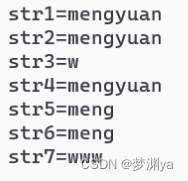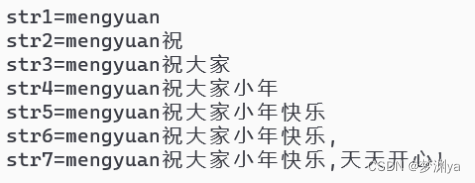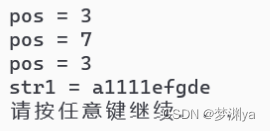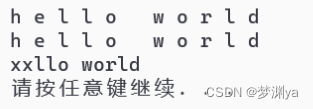文章目录
一、构造函数
构造函数原型:
1.string() 创建一个空的字符串
2.string(const char* s) 使用字符串s初始化
3.string(const string &str) 使用string对象初始化另一个string对象
4.string(int n,char c) 使用n个字符c初始化
代码:
#include<iostream>
#include<string>
using namespace std;
int main()
{
//1.string() 创建一个空的字符串
string str1;
cout<<"str1="<<str1<<endl;
//2.string(const char* s) 使用字符串s初始化
const char* s="mengyuan";
string str2(s);
cout<<"str2="<<str2<<endl;
//3.string(const string &str) 使用string对象初始化另一个string对象
string str3(str2);
cout<<"str3="<<str3<<endl;
//4.string(int n,char c) 使用n个字符c初始化
string str4(3,'w');
cout<<"str4="<<str4<<endl;
return 0;
}
结果:

二、赋值操作(=、assign)
函数原型:
1.string& operator=(const char* s); //char*类型字符串 赋值给当前的字符串
2.string& operator=(const string &s); //把字符串s赋给当前的字符串
3.string& operator=(char c); //字符赋值给当前的字符串
4.string& assign(const char *s); //把字符串s赋给当前的字符串
5.string& assign(const char *s, int n); //把字符串s的前n个字符赋给当前的字符串
6.string& assign(const string &s); //把字符串s赋给当前字符串
7.string& assign(int n, char c); //用n个字符c赋给当前字符串
代码:
#include<iostream>
#include<string>
using namespace std;
int main()
{
//1.string& operator=(const char* s); //char*类型字符串 赋值给当前的字符串
string str1="mengyuan";
cout<<"str1="<<str1<<endl;
//2.string& operator=(const string &s); //把字符串s赋给当前的字符串
string str2=str1;
cout<<"str2="<<str2<<endl;
//3.string& operator=(char c); //字符赋值给当前的字符串
string str3;//string str3='w';会报错
str3='w';
cout<<"str3="<<str3<<endl;
//4.string& assign(const char *s); //把字符串s赋给当前的字符串
string str4;
str4.assign("mengyuan");
cout<<"str4="<<str4<<endl;
//5.string& assign(const char *s, int n); //把字符串s的前n个字符赋给当前的字符串
string str5;
str5.assign("mengyuan",4);
cout<<"str5="<<str5<<endl;
//6.string& assign(const string &s); //把字符串s赋给当前字符串
string str6;
str6.assign(str5);
cout<<"str6="<<str6<<endl;
//7.string& assign(int n, char c); //用n个字符c赋给当前字符串
string str7;
str7.assign(3,'w');
cout<<"str7="<<str7<<endl;
return 0;
}
结果:

三、字符串拼接(+=、append)
函数原型:
1.string& operator+=(const char* str); //重载+=操作符
2.string& operator+=(const char c); //重载+=操作符
3.string& operator+=(const string& str); //重载+=操作符
4.string& append(const char *s); //把字符串s连接到当前字符串结尾
5.string& append(const char *s, int n); //把字符串s的前n个字符连接到当前字符串结尾
6.string& append(const string &s); //同operator+=(const string& str)
7.string& append(const string &s, int pos, int n); //字符串s中从pos开始的n个字符连接到字符串结尾
代码:
#include<iostream>
#include<string>
using namespace std;
int main()
{
//1.string& operator+=(const char* str); //重载+=操作符
string str1="meng";
str1+="yuan";
cout<<"str1="<<str1<<endl;
//2.string& operator+=(const char c); //重载+=操作符
string str2=str1;
str2+="祝";
cout<<"str2="<<str2<<endl;
//3.string& operator+=(const string& str); //重载+=操作符
string str3=str2;
string str="大家";
str3+=str;
cout<<"str3="<<str3<<endl;
//4.string& append(const char *s); //把字符串s连接到当前字符串结尾
string str4=str3;
str4.append("小年");
cout<<"str4="<<str4<<endl;
//5.string& append(const char *s, int n); //把字符串s的前n个字符连接到当前字符串结尾
string str5=str4;
str5.append("快乐aaa",4);
cout<<"str5="<<str5<<endl;
//6.string& append(const string &s); //同operator+=(const string& str)
string str6=str5;
string s=",";
str6.append(s);
cout<<"str6="<<str6<<endl;
//7.string& append(const string &s, int pos, int n); //字符串s中从pos开始的n个字符连接到字符串结尾
string str7=str6;
string s7="天天开心!";
str7.append(s7,0,10);
cout<<"str7="<<str7<<endl;
return 0;
}
结果:

四、字符串查找和替换(find、rfind、replace)
函数原型:
1.int find(const string& str, int pos = 0) const; //查找str第一次出现位置,从pos开始查找
2.int find(const char* s, int pos = 0) const; //查找s第一次出现位置,从pos开始查找
3.int find(const char* s, int pos, int n) const; //从pos位置查找s的前n个字符第一次位置
4.int find(const char c, int pos = 0) const; //查找字符c第一次出现位置
5.int rfind(const string& str, int pos = npos) const; //查找str最后一次位置,从pos开始查找
6.int rfind(const char* s, int pos = npos) const; //查找s最后一次出现位置,从pos开始查找
7.int rfind(const char* s, int pos, int n) const; //从pos查找s的前n个字符最后一次位置
8.int rfind(const char c, int pos = 0) const; //查找字符c最后一次出现位置
9.string& replace(int pos, int n, const string& str); //替换从pos开始n个字符为字符串str
10.string& replace(int pos, int n,const char* s); //替换从pos开始的n个字符为字符串s
代码:
#include<iostream>
#include<string>
using namespace std;
//查找和替换
void test01()
{
//查找
string str1 = "abcdefgde";
int pos = str1.find("de");//没找到返回-1,找到返回d的下标
if (pos == -1)
{
cout << "未找到" << endl;
}
else
{
cout << "pos = " << pos << endl;
}
pos = str1.rfind("de");//从右往左找
cout << "pos = " << pos << endl;
//3.int find(const char* s, int pos, int n) const; //从pos位置查找s的前n个字符第一次位置
pos=str1.find("ded",2,2);
if (pos == -1)
{
cout << "未找到" << endl;
}
else
{
cout << "pos = " << pos << endl;
}
}
void test02()
{
//替换
string str1 = "abcdefgde";
str1.replace(1, 3, "1111");//将bcd替换成1111 四个1
cout << "str1 = " << str1 << endl;
}
int main()
{
test01();
test02();
system("pause");
return 0;
}
结果:

五、字符串比较(compare)
- 字符串对比主要是用于比较两个字符串是否相等,判断谁大谁小的意义并不是很大
- 字符串比较是按字符的ASCII码进行对比
函数原型:
int compare(const string &s) const; //与字符串s比较
int compare(const char *s) const; //与字符串s比较
代码:
#include<iostream>
#include<string>
using namespace std;
//字符串比较
void test01()
{
string s1 = "hello";
string s2 = "aello";
int ret = s1.compare(s2);
if (ret == 0)
{
cout << "s1 等于 s2" << endl;
}
else if (ret > 0)
{
cout << "s1 大于 s2" << endl;
}
else
{
cout << "s1 小于 s2" << endl;
}
}
int main()
{
test01();
system("pause");
return 0;
}
结果:

六、字符存取([]、at)
函数原型:
1.char& operator[](int n); //通过[]方式取字符
2.char& at(int n); //通过at方法获取字符
代码:
#include<iostream>
#include<string>
using namespace std;
void test01()
{
string str = "hello world";
for (int i = 0; i < str.size(); i++)
{
cout << str[i] << " ";
}
cout << endl;
for (int i = 0; i < str.size(); i++)
{
cout << str.at(i) << " ";
}
cout << endl;
//字符修改
str[0] = 'x';
str.at(1) = 'x';
cout << str << endl;
}
int main()
{
test01();
system("pause");
return 0;
}
结果:

七、字符串插入和删除 (insert、erase)
函数原型:
1.string& insert(int pos, const char* s); //插入字符串
2.string& insert(int pos, const string& str); //插入字符串
3.string& insert(int pos, int n, char c); //在指定位置插入n个字符c
4.string& erase(int pos, int n = npos); //删除从Pos开始的n个字符
代码:
#include<iostream>
#include<string>
using namespace std;
//字符串插入和删除
void test01()
{
string str = "hello";
str.insert(1, "111");
cout << str << endl;
str.erase(1, 3); //从1号位置开始3个字符
cout << str << endl;
}
int main()
{
test01();
system("pause");
return 0;
}
结果:

八、子串获取(substr)
函数原型:
string substr(int pos = 0, int n = npos) const; //返回由pos开始的n个字符组成的字符串
代码:
#include<iostream>
#include<string>
using namespace std;
//子串
void test01()
{
string str = "abcdefg";
string subStr = str.substr(1, 3);
cout << "subStr = " << subStr << endl;
string email = "hello@sina.com";
int pos = email.find("@");
string username = email.substr(0, pos);//即@前面的
cout << "username: " << username << endl;
}
int main()
{
test01();
system("pause");
return 0;
}
结果:








 本文详细介绍了C++中字符串的基本操作,包括构造函数(空字符串、初始化)、赋值(字符、字符串),字符串拼接,查找和替换功能(find,rfind,replace),字符串比较,字符存取([]、at),以及插入、删除和子串获取(insert,erase,substr)。
本文详细介绍了C++中字符串的基本操作,包括构造函数(空字符串、初始化)、赋值(字符、字符串),字符串拼接,查找和替换功能(find,rfind,replace),字符串比较,字符存取([]、at),以及插入、删除和子串获取(insert,erase,substr)。














 3367
3367











 被折叠的 条评论
为什么被折叠?
被折叠的 条评论
为什么被折叠?








